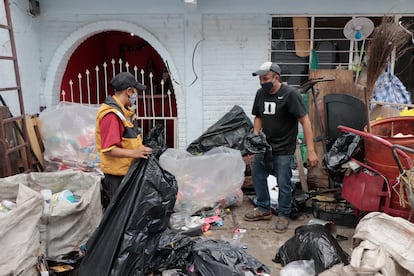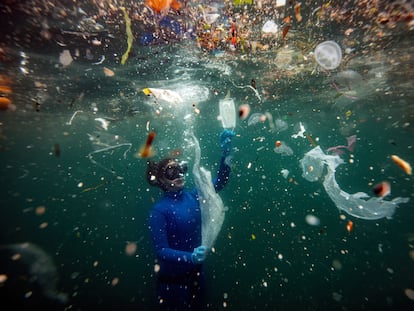Plastic colonialism: Mexico’s waste imports from the US double in two years
For the first time, an interactive map shows the cross-border trade of plastic waste to Mexico, which skyrocketed when China banned it

Mexico is Latin America’s largest importer of plastic waste and the main destination for the plastic waste generated and exported by the United States. Sending plastic waste - which can take hundreds of years to degrade – to Mexico is not new, according to available official statistics. However, shipments doubled between 2019 and 2021 to 167,548 tons, even after an international agreement to regulate cross-border trade of this material was implemented.
That’s one of the main findings of the Plastic Waste Colonialism and Its Use as Fuel in Mexico project, a digital statistical map developed by groups on the GAIA environmentalist website. The project went live last Monday. The map brings together the extant figures on the cross-border transport of plastic waste in the country for the first time on a single website. Until now, there has been a dearth of information on the subject.
The organizations and researchers we consulted agreed that it is difficult to obtain reliable information that allows for a clear picture of this issue. In addition, they claim that Mexican environmental authorities lack data beyond economic figures. “Neither Semarnat [Ministry of the Environment and Natural Resources] nor Profepa [Federal Attorney’s Office for Environmental Protection] has information about the transport of plastic waste, so there is no certainty about whether the waste is hazardous or where it goes after it enters the country,” says Marisa Jacott, the director of Fronteras Comunes, one of the organizations that prepared the map.
According to Alethia Vázquez, a professor and researcher at the Universidad Autónoma Metropolitana-Azcapotzalco (Autonomous Metropolitan University-Azcapotzalco), an expert in urban waste, there are numerous gaps in the available information about plastics. “We lack data. We don’t know, for example, how much is recycled in Mexico, we can find out what is imported, what is officially registered, but there is a lot of illegal importation,” says the expert, who coordinated the first National Inventory of Plastics in Mexico presented last Friday. The federal government commissioned this initiative with funding from the United Nations.
“Waste colonialism”
Based on information from SIAVI, Mexico’s main tariff information bank – which stopped being updated in 2022 - the interactive map shows that plastic waste imports from the United States, under tariff item 3915, went from 73,534 tons in 2019 to 167,548 tons in 2021. Waste from Mexico’s main trading partner represents 95% of the total plastic waste arriving in the country. In addition, according to this data, the country also received plastic waste in 2021 from Italy (1771 tons), Guatemala (1356), Germany (993) and Austria (733). America Futura tried unsuccessfully to obtain the 2022 figures through the National Association of the Plastics Industry.
Environmental organizations that monitor this phenomenon have called it “plastic waste colonialism,” as seen in exports from the United States to Latin America and from Europe to Southeast Asia. “It is a form of environmental domination or exploitation that occurs through the transboundary shipment of waste from developed countries to less developed ones,” says Marisa Jacott of Common Frontiers. It is usually toxic or difficult-to-manage waste that is being sent from developed countries to the most disadvantaged countries and those with weak legislation.
The increase in plastic waste imports to Mexico can be explained by China’s ban on that type of import, the Mexican authorities’ lax supervision and the incomplete implementation of the Basel Convention’s Plastics Amendment. However, Alethia Vázquez believes the biggest problem is domestic: “It stems from our consumption of plastic in Mexico. That is the biggest contribution to plastic pollution. Twenty years ago, plastic represented 5% of all the waste generated and now it’s between 15% and 20%”.
The rebound effect of the Chinese ban
The map compiles data since 2015, when Mexico received 53,264 tons of plastic waste. It shows that shipments from the United States and other countries have remained constant over the years, with some annual increases, and peaked in 2020 and 2021. One possible explanation is that China closed its borders to plastic waste imports in 2018 after having served as the primary destination for them. A year earlier, that country received some 7.3 million tons of plastic waste from developed countries.
“China was receiving 70% of the plastic waste from the European Union, Japan and the United States, which were flooding its territory,” Jacott says. China’s prohibition certainly impacted international trade flows and could be responsible for Mexico’s increased imports. According to experts, another reason for that spike is that the Mexican government has not finished implementing the Amendment to the Basel Convention on the Control of Transboundary Movements of Hazardous Wastes and their Disposal, which went into effect in January 2021.
The amendment is intended to regulate and reduce the international transport of plastics that include hazardous waste. Countries exporting contaminated plastics are required to request permission from the receiving country, while clean plastics for recycling still do not require prior authorization because of changes to Annex 9 of the agreement.
The nearly 68% increase in Mexican imports of waste from the United States in 2021 demonstrates that the implementation is not complete, says José Manuel Arias, the director of the Santo Tomás Ecological Association. The problem stems from plastics that are considered non-hazardous and therefore do not require a permit. “Semarnat does not impose any controls on these imports. Its regulations are totally lax about the entry of this [type of] waste,” says Arias. The environmentalist assumes that countless unrecyclable plastics enter the country protected by this addendum, but there are no inspections.
The incineration problem
There isn’t a real sense of the impact of importing plastic waste. In a letter to the Senate about the Convention Amendment, Mexican President Andres Manuel Lopez Obrador saw the fact that Mexico recycles waste for the United States as a positive, which Arias attributes to the business that the practice could represent.
Environmental organizations warn of the immediate risk of increased incineration as a method for recycling plastic. Mexico’s waste management law permits it, but it is another source of pollution. “Soft drink companies and food producers say they comply with recycling, but they are burning all their plastics,” says Marisa Jacott. The beneficiaries of this phenomenon are cement companies that burn plastic waste as fuel and save millions of dollars in gas, she adds.
However, if Mexico refused to import this material, it could not justify being a heavy exporter of plastic waste. According to GAIA, between 2016 and 2021, the country sent over 750,000 tons to other countries, a figure that suggests the possibility that Mexico receives waste to reship it elsewhere.
Sign up for our weekly newsletter to get more English-language news coverage from EL PAÍS USA Edition
Tu suscripción se está usando en otro dispositivo
¿Quieres añadir otro usuario a tu suscripción?
Si continúas leyendo en este dispositivo, no se podrá leer en el otro.
FlechaTu suscripción se está usando en otro dispositivo y solo puedes acceder a EL PAÍS desde un dispositivo a la vez.
Si quieres compartir tu cuenta, cambia tu suscripción a la modalidad Premium, así podrás añadir otro usuario. Cada uno accederá con su propia cuenta de email, lo que os permitirá personalizar vuestra experiencia en EL PAÍS.
¿Tienes una suscripción de empresa? Accede aquí para contratar más cuentas.
En el caso de no saber quién está usando tu cuenta, te recomendamos cambiar tu contraseña aquí.
Si decides continuar compartiendo tu cuenta, este mensaje se mostrará en tu dispositivo y en el de la otra persona que está usando tu cuenta de forma indefinida, afectando a tu experiencia de lectura. Puedes consultar aquí los términos y condiciones de la suscripción digital.
More information
Archived In
Últimas noticias
Rowan Atkinson tops Netflix at 70: ‘He’s as funny as ever’
Israeli recognition of Somaliland stirs up the Gulf
Tiger Woods turns 50: Will he continue playing on the PGA Tour or take a back seat?
The surreal journey of James Nnaji, the Barcelona youth player selected in the NBA Draft who ended up in the NCAA
Most viewed
- Oona Chaplin: ‘I told James Cameron that I was living in a treehouse and starting a permaculture project with a friend’
- Reinhard Genzel, Nobel laureate in physics: ‘One-minute videos will never give you the truth’
- Sinaloa Cartel war is taking its toll on Los Chapitos
- Why the price of coffee has skyrocketed: from Brazilian plantations to specialty coffee houses
- Chevy Chase, the beloved comedian who was a monster off camera: ‘Not everyone hated him, just the people who’ve worked with him’










































